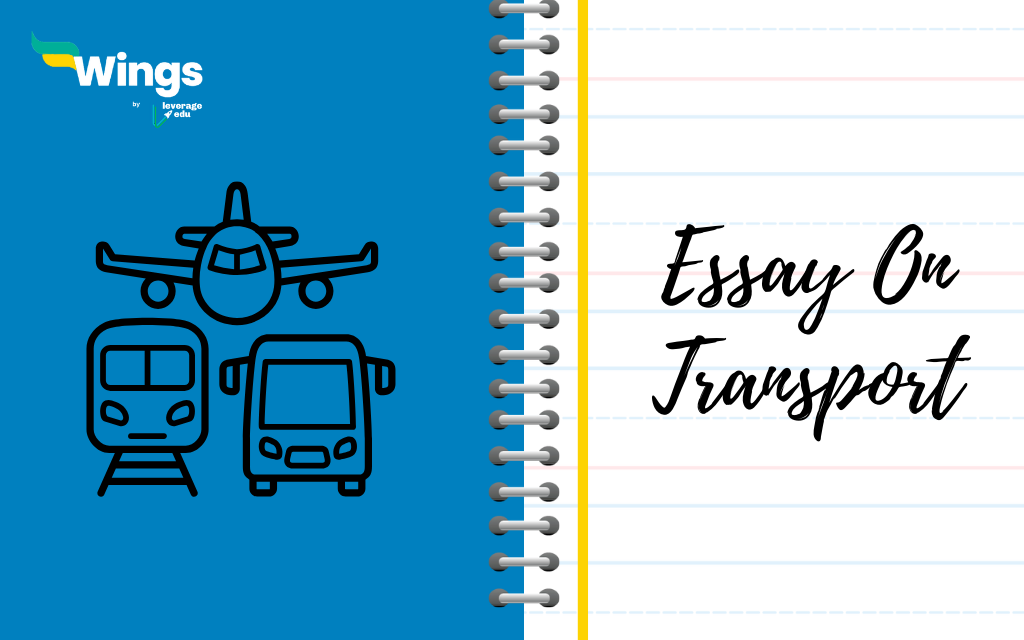Essay on Transport: There are four transport modes: air, water, land and rail. Railways and roads are the most commonly used modes of transport. The Grand Trunk Road or the GT Road is one of the world’s oldest roads and the largest in Asia. Since the domestication of animals in the Mesolithic period, humans started to work on different types of transport mechanisms. Developments in transport systems have come a long way. Today, aeroplanes and jets are the fastest modes of transport. Humans have built jets. Some of the fastest planes and jets are the USAF X-15, SR-71 Blackbird, and MIG-25 Foxbat.
Contents
Also Read: Speech on Make Public Transport Free
Essay on Transport in 150 Words
Transport is an essential part of our daily lives. It helps people move from one place to another and allows goods to be transported across cities, countries, and continents. There are three main types of transport: land, water, and air.
Land transport includes cars, buses, trains, and bicycles. It is the most commonly used mode of transportation. According to a 2023 report, India has over 350 million registered vehicles, and the number is increasing every year. Water transport, such as ships and boats, is mainly used for international trade and travel. About 80% of global trade happens through sea routes. Air transport is the fastest but the most expensive way to travel. Airports handle over 4 billion passengers worldwide annually.
Efficient transport systems boost the economy, improve trade, and make life easier. However, traffic congestion, pollution, and rising fuel prices are challenges. Governments are promoting electric vehicles and metro rail projects to reduce pollution. The Indian Railways, for example, is working towards running fully electric trains by 2030 to cut carbon emissions.
In conclusion, transport is vital for progress, but we must adopt eco-friendly solutions to ensure a sustainable future.
Also Read: Essay on Media
Essay on Transport in 250 Words
Transport plays a crucial role in modern civilization. It enables people and goods to travel quickly and efficiently. There are various types of transport, such as road, rail, water, and air. Each has its advantages and challenges.
Road transport is the most widely used form of transport. India has over 6.37 million kilometers of roads, making it the second-largest road network in the world. Trucks, buses, cars, and two-wheelers are common modes of road transport. However, road congestion and pollution are growing concerns.
Rail transport is an economical and eco-friendly option. The Indian Railways is one of the largest railway networks, carrying over 8 billion passengers annually. Trains are used for both passenger and freight services, reducing road traffic.
Water transport is one of the oldest and cheapest modes of transport. It is mainly used for global trade. The Jawaharlal Nehru Port in Mumbai is India’s largest container port, handling millions of tons of cargo every year. However, water transport is slow and depends on weather conditions.
Air transport is the fastest mode and is widely used for international travel and emergencies. India has more than 150 operational airports, with Indira Gandhi International Airport in Delhi being the busiest. However, it is expensive and contributes significantly to carbon emissions.
With rising pollution and fuel consumption, governments are focusing on electric vehicles, bullet trains, and improved public transport. Sustainable solutions like metro rail systems and electric buses are being promoted.
Transport has transformed the world, but we must make it more efficient and eco-friendly for a better future.
Also Read: Essay on Chandrayaan-3
Essay on Transport in 350 Words
Transport is the backbone of economic and social development. It connects people, facilitates trade, and supports industries. The world has seen tremendous advancements in transport, from bullock carts to electric trains and airplanes.
Types of Transport
- Road Transport
Road transport is the most commonly used mode. India has over 1.4 million buses serving public transport needs. However, increasing traffic congestion and rising pollution levels are significant concerns. In response, the government is promoting electric vehicles and CNG-powered buses. The Delhi Metro has reduced road traffic and lowered air pollution levels in the capital. - Rail Transport
Railways are an essential part of India’s transport system. The Vande Bharat Express, India’s first semi-high-speed train, has improved rail travel significantly. Indian Railways plans to be carbon neutral by 2030, focusing on electrification and renewable energy sources. - Water Transport
Water transport is used for both domestic and international trade. Inland waterways in India are being developed to reduce pressure on roads and railways. The Ganga Waterway Project is an initiative to boost cargo transport on rivers. - Air Transport
Air travel has become affordable and accessible to more people. India’s UDAN scheme has improved regional air connectivity, making air travel available to smaller towns. However, air transport remains a significant contributor to carbon emissions.
Challenges in the Transport Sector
- Traffic congestion: Major cities like Mumbai and Bengaluru face severe traffic jams.
- Pollution: Vehicles contribute 40% of total air pollution in cities.
- Fuel price hikes: The increasing cost of petrol and diesel affects transport costs.
Solutions for Sustainable Transport
Governments worldwide are focusing on green transport solutions. The use of electric buses, bike-sharing programs, and high-speed rail networks is increasing. India is also investing in hydrogen-powered trains and smart traffic management systems to improve efficiency.
In conclusion, transport is essential for progress, but its environmental impact must be reduced. Sustainable innovations and government initiatives will shape the future of transport.
Also Read: Essay on Gaganyaan
FAQs
Ans: Transport refers to the movement of humans and goods through different means. There are different modes of transport, such as roads, railways, air and sea. Early humans used to walk to travel to different places. Later on, with the domestication of animals, people started to ride large animals like horses and elephants. Modern transportation is the result of inventions like wheels, steam engines and aeroplanes. Roadways and railways are the most popular and commonly used means of transport. Air and Sea transports are used to travel to distant places or different countries. Travelling by sea is environmentally friendly as other means of transport use fuels like petrol and diesel, which release carbon dioxide into the atmosphere.
Ans: Road, rail, air and sea are the different modes of transport.
Ans: The oldest mode of transport includes walking, running, swimming and animal riding
Ans: Transport helps people and goods move from one place to another quickly and efficiently. It supports businesses, trade, and daily activities, making life more convenient.
Ans: The main types of transport are road transport (cars, buses, bicycles), rail transport (trains, metro), water transport (boats, ships), and air transport (airplanes, helicopters). Each type serves different purposes based on speed, cost, and distance.
Ans: Using electric vehicles, bicycles, public transport, and alternative fuels like CNG and hydrogen can help reduce pollution. Governments are also promoting metro rail projects and green energy solutions to improve sustainable transport.
Related Articles
| Essay on Guru Nanak Jayanti | Essay on Solar System for School Students |
| Essay on Online Shopping | Essay on Tiger |
| Essay on Disaster Management | Essay on Media |
| Essay on Politics | Essay on Knowledge is Power |
For more information on such informative articles for your school, visit our essay writing page and follow Leverage Edu.
 One app for all your study abroad needs
One app for all your study abroad needs














